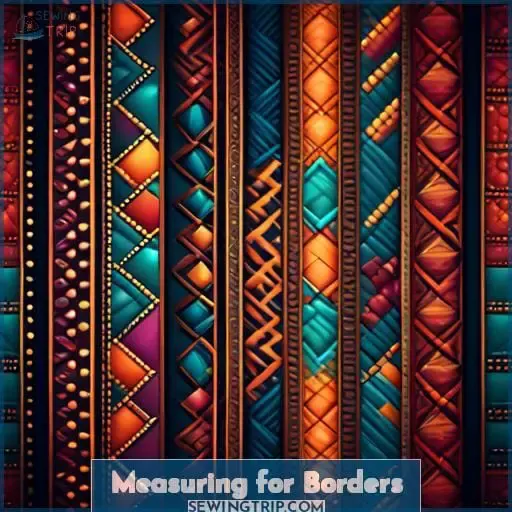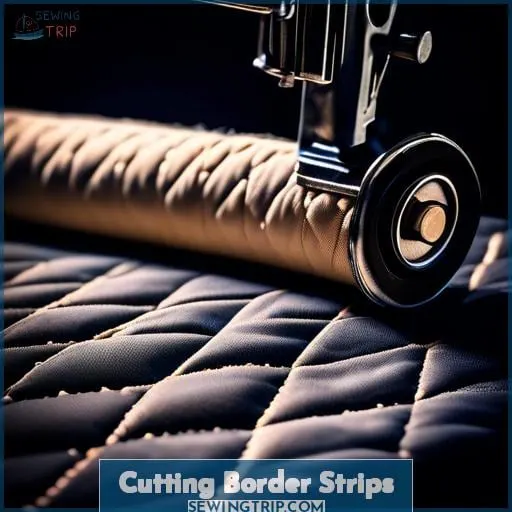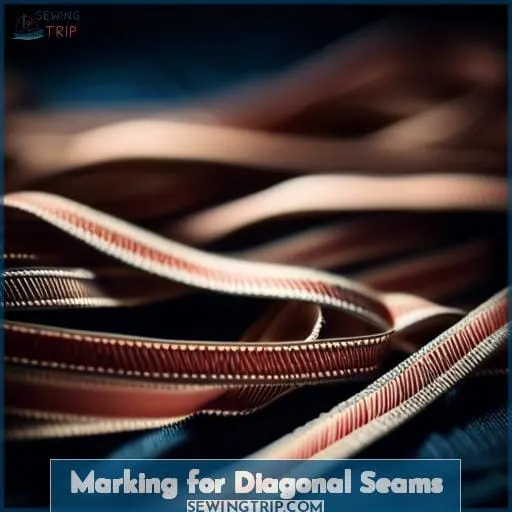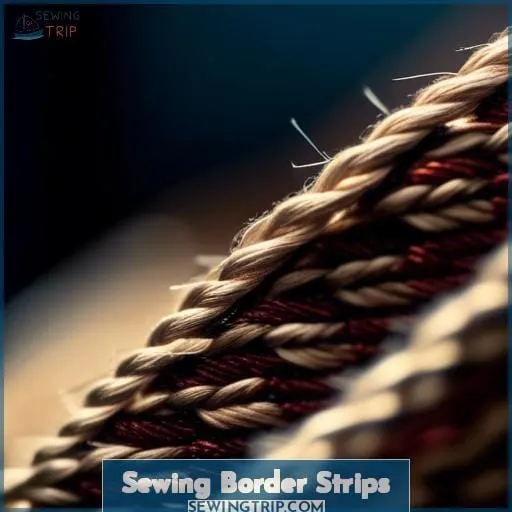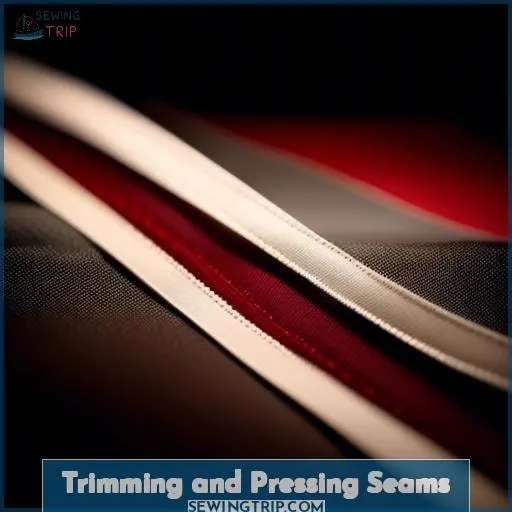This site is supported by our readers. We may earn a commission, at no cost to you, if you purchase through links.
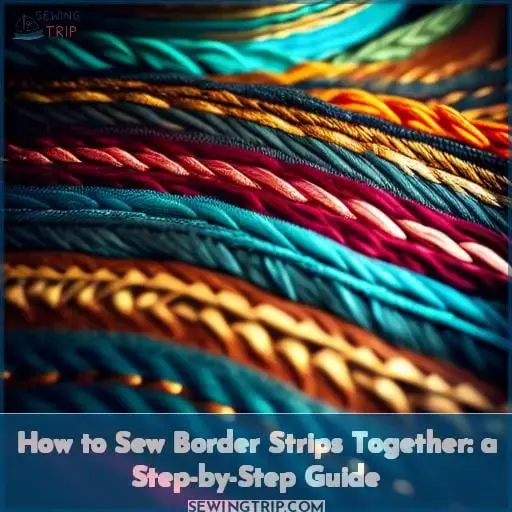 Bolster your borders beautifully by binding strips seamlessly. You’ll master the meticulous art of joining border strips, ensuring your quilt’s edges exude elegance and exhibit exceptional craftsmanship.
Bolster your borders beautifully by binding strips seamlessly. You’ll master the meticulous art of joining border strips, ensuring your quilt’s edges exude elegance and exhibit exceptional craftsmanship.
This guide empowers you to understand and execute each step with precision, from cutting to sewing, so your quilt not only looks stunning but also feels like a part of a cherished quilting community.
Let’s dive into the detailed process of piecing together border strips for a quilt that’s as flawless as it is fulfilling.
Table Of Contents
Key Takeaways
- Measure quilt top length in three places (top, middle, bottom) and average these measurements to determine the correct width for border strips, including a 1/2 inch for seam allowances.
- For precision in cutting border strips, use a cutting mat grid to ensure straight cuts and align fabric with the grid, cutting strips to the exact required width.
- When joining border strips, especially for longer borders, align them perpendicularly and sew precisely along a drawn diagonal line to ensure a nearly invisible seam, trimming excess fabric while maintaining a 1/4 inch seam allowance for borders.
- Press seam allowances to one side for borders to reduce bulk and ensure a neat finish, enhancing the overall appearance of the quilt.
How to Sew Border Strips Together
Yes, to sew border strips together, lay one strip horizontally and another vertically on top, ensuring they are perpendicular, and sew along a diagonal line drawn from corner to corner. This method creates an almost invisible seam and distributes the bulk of the seam allowances.
Measuring for Borders
When you’re ready to add borders to your quilt, it’s crucial to measure accurately for a polished finish.
You’ll want to calculate the length of your quilt top in three places—top, middle, and bottom—to ensure precision.
Keep in mind the width of your borders should include an extra 1/2 inch for seam allowances.
Accurate Length Calculation
To ensure your quilt border strips are the perfect length, you’ll want to measure with precision. Start by deciding the width of your borders, then measure your quilt top’s length in three places to get an average—this is your strip width.
Next, draw a 45-degree angle on your fabric strips to join them, ensuring they’re perpendicular for a seamless look. When sewing, follow these angles closely, as they’re the backbone of your quilting craftsmanship.
Width Considerations
When considering the width of your quilt borders, it’s essential to strike a balance that complements your quilt’s design. You’re not just framing your masterpiece; you’re adding a chapter to its story. Think of border strip widths as the final brushstrokes on a canvas, where narrow border strips can act as delicate outlines, and wider border strips provide a bold statement.
For a harmonious transition, joining wide strips may require a straight seam, especially if they exceed 3.5 inches, to maintain the fabric’s pattern integrity. Conversely, narrow strips often benefit from a diagonal seam, which can blend more seamlessly into the quilt’s overall aesthetic.
When cutting your quilt border lengths, remember that precision is your ally. Measure your quilt top in three places to ensure accuracy. As you embark on quilt border cutting, let the fabric guide you. Whether you’re working with a solid color or a playful print, place your seams thoughtfully to keep them discreet.
In the dance of assembling your quilt, each step from measuring to pressing is a move towards a cohesive whole. Your quilt isn’t just a collection of fabric; it’s a tapestry of your skill and vision. So, as you select your border fabric choices, let your creativity lead the way, and remember, the journey is as rewarding as the destination.
Cutting Border Strips
When it comes to cutting border strips for your quilting project, precision and alignment are key.
You’ll want to ensure your strips are cut to the exact width needed, using your cutting mat’s grid to achieve straight, accurate cuts.
This meticulous approach not only sets the foundation for beautiful borders but also enhances the overall quality of your quilt.
Precision in Strip Width
In the realm of quilting, precision in strip width isn’t just a step; it’s an art form that bridges your vision with the tangible beauty of your quilt. When you’re cutting border strips, think of yourself as a sculptor, where each slice of the fabric is a deliberate stroke shaping the final masterpiece.
Your ruler and cutting mat are your chisels, ensuring every cut is as straight and true as the notes in a symphony.
First, measure twice, cut once—this age-old adage holds especially true here. Your strip measurement and width calculations are the foundation of your quilt’s borders, setting the stage for a quilt that lies flat and looks professional.
Ensure your cutting accuracy by aligning your fabric with the grid on your cutting mat, using a ruler or straight edge as your guide. This precision ensures your strips are consistent, which is crucial for the seamless joining of each piece.
When it comes to sewing, precise seams are your best friend. They transform your accurately cut strips into a harmonious border that frames your quilt top beautifully. Remember, a quilt is more than fabric and thread—it’s a tapestry of your dedication and skill.
By measuring carefully, cutting with precision, and sewing with consistency, you’re not just creating a quilt; you’re weaving a story, square by square, seam by seam.
Aligning for Straight Cuts
When it comes to aligning for straight cuts, your cutting mat and measurement grids become your best friends.
Picture this: you’re an artist, and your fabric is your canvas. You wouldn’t start painting without sketching your masterpiece first, right? Similarly, before making a cut, lay your fabric on the cutting mat, letting the measurement grids guide your vision.
Use a ruler or straight edge as your paintbrush, drawing cutting lines with precision and confidence.
Imagine pinning the border strips as if you’re sketching out the future of your quilt, ensuring every piece is perfectly aligned for that seamless look.
Marking for Diagonal Seams
When it comes to sewing border strips together, drawing a 45-degree line and aligning your strips for joining are crucial steps.
You’ll want to lay out your fabric strips on a cutting mat, ensuring they’re positioned correctly before marking the diagonal line that will guide your sewing.
This approach not only ensures precision but also enhances the overall appearance of your quilt borders.
Drawing 45-Degree Lines
Once you’ve cut your fabric strips to the precise width for your quilt borders, it’s time to join them with accuracy.
Lay your strips on the cutting mat, ensuring the grid lines guide your placement. Now, draw a 45-degree line across the strip ends—this angle measurement is crucial for a seamless join.
Align the strips so their edges are flush, using the grid for fabric alignment. When you pin, remember to keep the pins clear of the sewing path.
Sewing the border with precision cutting and accurate seam allowance will make your pieced border the crowning glory of your quilt. As you quilt border pinning and sewing the border, imagine the admiration it will garner, a testament to your skill and a bridge to fellow quilters, a shared language of craft and care.
Aligning Strips for Joining
When aligning your fabric strips for that perfect quilt border, think of it as a dance of color and precision. You’ve chosen your Kona Snow fabric, a canvas of pure white, ready to be framed by meticulously joined strips.
Now, imagine your cutting mat as the stage, the grid lines guiding your every move. Lay one strip right side up, horizontal and true, then a partner strip, wrong side up, vertical and just as precise.
They should overlap like two paths destined to meet, edges extending just beyond the mat’s grid, hinting at the journey beyond.
Now, it’s time to draw that 45-degree line, a diagonal path that your stitches will soon follow. It’s like plotting a course on a map, ensuring your fabric’s journey is both straight and true. Pin them together, not too close to the line, like setting waypoints that guide but don’t obstruct.
As you sew, let the rhythm of your machine echo the heartbeat of your project. The thread choice, a silent partner in this dance, must complement the fabric, never overshadowing. Once joined, press the seams with care—toward one side for borders, open for binding, as if smoothing the path for the next stage of your quilt’s adventure.
Pinning Strips for Sewing
When pinning your fabric strips for sewing, it’s essential to place your pins accurately and ensure the strips are aligned perpendicularly.
This careful alignment prevents fabric from shifting and maintains the precision of your quilt borders.
Proper Pin Placement
Once you’ve drawn your 45-degree lines for the diagonal seams, it’s time to focus on proper pin placement. Pin types and sizes matter; for quilting, pins around 1.5 to 2 inches long are ideal. When pinning your quilt border strips, aim for pin density that’s just right—not too sparse, not too crowded.
For securing your quilt border, place pins every 4-6 inches along the strip, aligning them with the drawn line and ensuring the strips remain perpendicular. Remember to set pins back from the line slightly to avoid interference while sewing.
As for pin storage, keep them organized and within reach—magnetic trays are a lifesaver for easy pin removal and keeping your workspace tidy.
When joining quilt border strips end to end or folding them for mitered corners, the pins help maintain alignment before and during sewing. If you’re working with a quilt border longer than your strips, joining multiple strips with pins will help manage the fabric.
Always press your seams as directed—toward the border for a flat finish or open for binding—to reduce bulk and give your quilt a professional look.
Ensuring Perpendicular Alignment
Continuing from the previous discussion on proper pin placement, let’s delve into ensuring perpendicular alignment when pinning strips for sewing. This step is crucial for maintaining the integrity of your quilt pattern and achieving a polished quilt border finish.
- Pin Alignment: Make sure your pins are placed at right angles to the seam line to maintain seam accuracy.
- Perpendicular Strips: Check that the fabric strips are perpendicular to each other before sewing to avoid a quilt border that’s askew.
- Fabric Positioning: Align your fabric strips carefully on the cutting mat to ensure that your quilt border doesn’t end up larger on one side.
Sewing Border Strips
When you’re ready to sew your border strips together, it’s essential to stitch precisely on the drawn line to ensure a seamless join.
Maintain a consistent seam allowance, typically 1/4 inch for borders and 3/8 inch for binding.
Stitching on the Line
When stitching border strips together, it’s essential to maintain precision and alignment to avoid wavy borders and ensure a continuous, professional look. After joining your strips, whether with a diagonal seam for a less noticeable join or a straight seam for patterns like stripes or plaids, it’s time to stitch on the drawn line.
| Step | Detail |
|---|---|
| 1. Align | Ensure the fabric strips are perfectly perpendicular before sewing. |
| 2. Stitch | Sew directly on the marked diagonal line to join strips. |
| 3. Trim | Cut away excess fabric, leaving a 1/4 seam allowance for borders, 3/8 for binding. |
| 4. Press | Use pressing techniques to press seam allowances to one side for borders, open for binding. |
Seam Allowance Consistency
After stitching along the drawn line, maintaining seam allowance consistency is crucial for a polished look.
- Accuracy: A uniform seam allowance ensures each quilt strip aligns perfectly with your quilt pieced top, avoiding puckers.
- Consistency: It’s the secret sauce for seamless quilt backing and fabric integration, making your quilt look professionally done.
- Pressing Techniques: Proper pressing, whether open or to one side, complements consistent seam allowances, laying the groundwork for successful mitering and a flat, crisp quilt.
Trimming and Pressing Seams
When sewing border strips together, it’s crucial to trim and press seams properly to reduce bulk and ensure a smooth finish.
You’ll want to trim away excess fabric, leaving a 1/4 seam allowance for borders and about 3/8 for binding.
For borders, press the seam allowance to one side, while for binding, press the seam open to distribute the bulk evenly.
Reducing Bulk in Seams
After sewing your border strips, it’s time to tackle the bulk. You’ll want to trim seams to a neat quarter-inch allowance, creating a crisp, flat fell seam.
This step is like sculpting: precise cuts transform bulky edges into sleek lines. Then, press seams diligently—one side for borders, open for binding. It’s like ironing out life’s wrinkles, leaving a smooth path for your quilt batting.
For a handy reference, grab the pdf version of this article from our library of all the printable blog post files.
Pressing Techniques for Borders and Binding
After reducing bulk in your seams, it’s time to finesse your quilt borders and binding with the right pressing techniques.
- Adjust your presser foot pressure to accommodate different seam allowances and types of fabric.
- Use steam judiciously; it can work wonders for stubborn wrinkles but may distort fabric if overused.
- Decide between hand vs machine pressing based on the precision needed and the fabric’s behavior.
- Always press seams to one side for borders and open for binding to reduce bulk and enhance the quilt’s flatness.
Mitering Corners for Borders
Mitering corners for borders is a crucial step in achieving a polished and continuous look on your quilt. Cutting for mitered corners requires precision and an understanding of the fabric’s direction, ensuring that the design flows seamlessly around the quilt.
Sewing mitered corners involves careful stitching and alignment to create that perfect angled join, enhancing the quilt’s overall appearance and giving it a professional finish.
Cutting for Mitered Corners
To achieve the elegance of mitered corners for your quilt borders, you’ll need to cut your fabric with precision and care. Imagine your quilt as a canvas, and the borders are the frame that brings the entire masterpiece into focus.
The mitered corner is like a subtle stroke of the brush that guides the eye around your quilt without interruption.
Here’s a table to guide you through the process of cutting for mitered corners:
| Step | Description |
|---|---|
| 1 | Measure the width of your quilt and add twice the border width plus 2 inches for seam allowances. |
| 2 | Cut two strips to this length for the top and bottom borders. |
| 3 | Repeat the measurement for the quilt’s length to cut the side border strips. |
| 4 | Mark the 45-degree angle on the border strips where they’ll meet at the corners. |
| 5 | Align the border strips with the quilt edges, right sides together, and pin in place, ready for sewing. |
As you handle the fabric, let the cutting mat and ruler be your trusted companions, ensuring every angle line is sharp and every fabric alignment is true. Your pin placement should be as precise as a painter’s touch, and the 45-degree angle cut will be the cornerstone of your quilt’s border, a testament to your dedication to the craft.
Remember, each stitch and cut is a step on the path to mastery, and with each quilt, you weave a little more of yourself into the tapestry of the quilting community.
Sewing Mitered Corners
To sew mitered corners for your quilt borders, you’ll need to embrace precision and patience, as this technique is all about the details.
After sewing your border strips to the quilt top, stop a quarter inch from the quilt’s edge and backstitch to secure.
Now, for the magic of mitering: fold your quilt diagonally, aligning the borders you’re about to join. With a ruler, draw a line at a 45-degree angle—this is your miter guideline. Pin along this line to keep everything in place.
As you sew along this line, start at the inner corner where your previous stitches ended, ensuring a seamless transition.
Once you’ve sewn your mitered seam, check that the corner lies flat and trim the excess fabric, leaving a 1/4-inch seam allowance. Press the seam open to reduce bulk and admire the crisp, continuous line you’ve created.
If you’re unsure about your miter angles, consider using a miter template or miter clamp to guide you. And remember, practice makes perfect—each corner you miter brings you closer to mastery and a quilt that’s a true work of art.
Frequently Asked Questions (FAQs)
Can I mix fabric types for borders?
Sure, you can mix fabric types for borders, but it’s like blending spices in a stew—each brings its own flavor.
Just ensure they’re all pre-washed to avoid a quilt that puckers and warps.
How do I fix a wavy border after sewing?
Just like a ship navigating through turbulent waters requires a skilled captain to adjust its sails, fixing a wavy border after sewing demands a quilter’s adept hands and a keen eye for detail.
Imagine your quilt as a canvas, where every stitch is a brushstroke contributing to the masterpiece. To smooth out those waves, consider these methods: easing the borders as you load them onto your frame, redoing the border, employing spray starch and steam, taking a tuck, or quilting the quilt as is with strategic design choices.
Each technique is a tool in your arsenal, ready to tackle the challenge and ensure your quilt sails smoothly to completion.
What is the best stitch length for borders?
For sewing borders, you’ll want to use a medium stitch length, which typically means setting your machine to about 2n
This length is a sweet spot that ensures your stitches are secure yet not too tight, preventing puckering and allowing for smooth, flat borders that truly frame your quilt masterpiece like a pro.
How do I choose border width for balance?
Choosing the width of your quilt’s border is like selecting the perfect frame for a masterpiece painting. Just as a frame complements and enhances the art within, the border of your quilt should balance and highlight the beauty of your work.
Think of your quilt blocks as the central theme of a story, with the border serving as the narrative that ties everything together. A border too wide might overshadow the tale your quilt tells, while one too narrow may not give it the emphasis it deserves.
A good rule of thumb is to use a border width that’s proportionate to the size of your quilt blocks. For a quilt with 12-inch blocks, consider borders that are 3, 4, 6, or 9 inches wide. This approach ensures your quilt’s story is framed just right, inviting viewers into the world you’ve stitched together.
Can borders be added without piecing?
Yes, borders can be added without piecing if the fabric length is sufficient for your quilt’s perimeter.
Conclusion
Mastering the method of sewing border strips together marks a milestone in your quilting journey. By carefully measuring, cutting, and stitching, you’ve prepared your quilt for a polished finish.
Your quilt now not only looks stunning but also reflects your dedication to quality and artistic expression.

